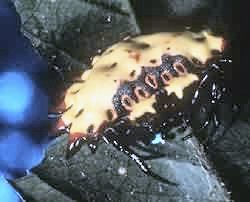 |
 |
 |
- Spider, common name for about 34,000 species
of arthropod animals having eight walking legs, head appendages
bearing fangs and poison glands, and specialized reproductive
organs on the second appendages of the male.
|
- Like other arachnids, spiders are terrestrial,
although one species has adapted to freshwater life by trapping
air bubbles underwater and carrying the bubbles with them.
|
Spiders are numerous and occur throughout
the world. Although most are less than 1 cm (0.4 in) long, the
largest has a body length of about 9 cm (3.6 in), and the leg
spans of some spiders can be much greater.
|
|
The black widow is venomous, as are
most spiders. The black widow's venom is a neurotoxin, a poison
that affects nerves such as those that control breathing.
|
- Capable of jumps up to 40 times its
body length, the jumping spider spins a silk safety line in case
it misses its target.
|
- Funnel spiders design their webs with
a small opening, or funnel, at the bottom, in which the spider
lies in wait.
|
- They commonly make extensive use of
silk, which they spin.
|
In humans, the bite of the black widow
is usually more toxic to children than to adults.
|
- The web of the funnel spider is built
above the ground to intercept flying insects.
|
- The goldenrod spider is a typical crab
spider common across much of North America. It can change from
white to yellow when waiting on flowers to ambush prey. This
species is also known as the flower spider.
|
The wolf spider belongs to a group
of spiders that live in burrows and lie in wait for unsuspecting
prey rather than capturing them in webs.
|
- Wolf spiders belong to the order Araneae,
which contains approximately 30,000 species and 70 families of
spider.
|
- Wolf spiders carry their newly hatched
young on their backs.
|





